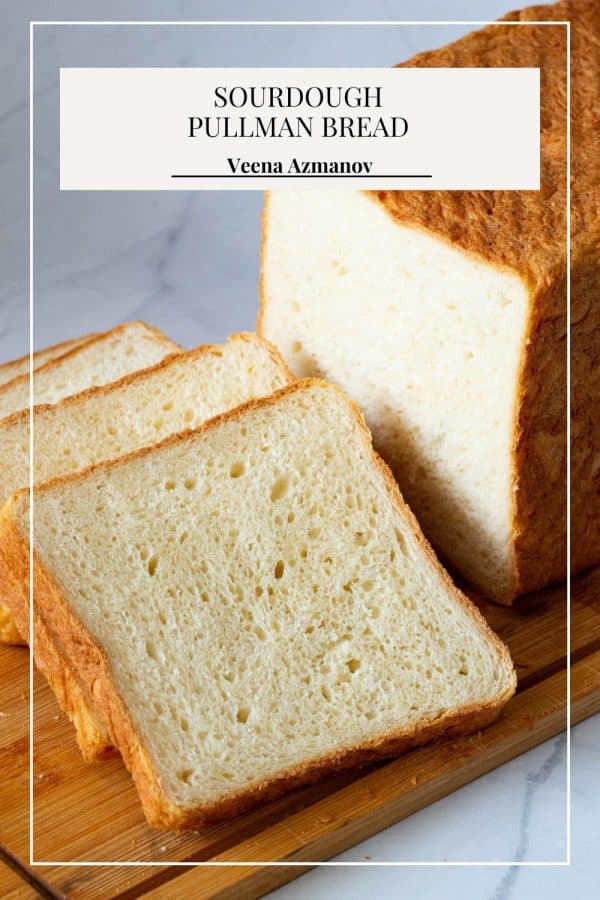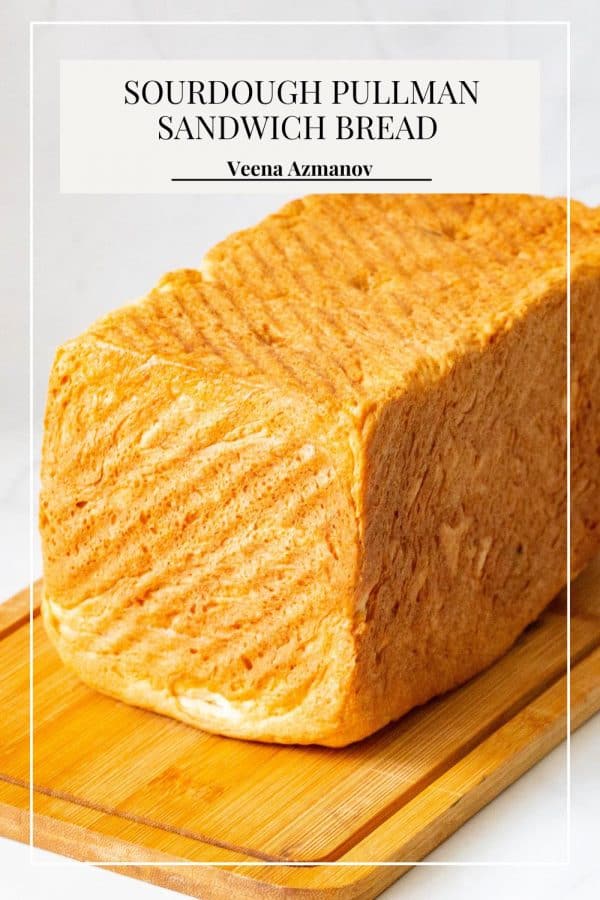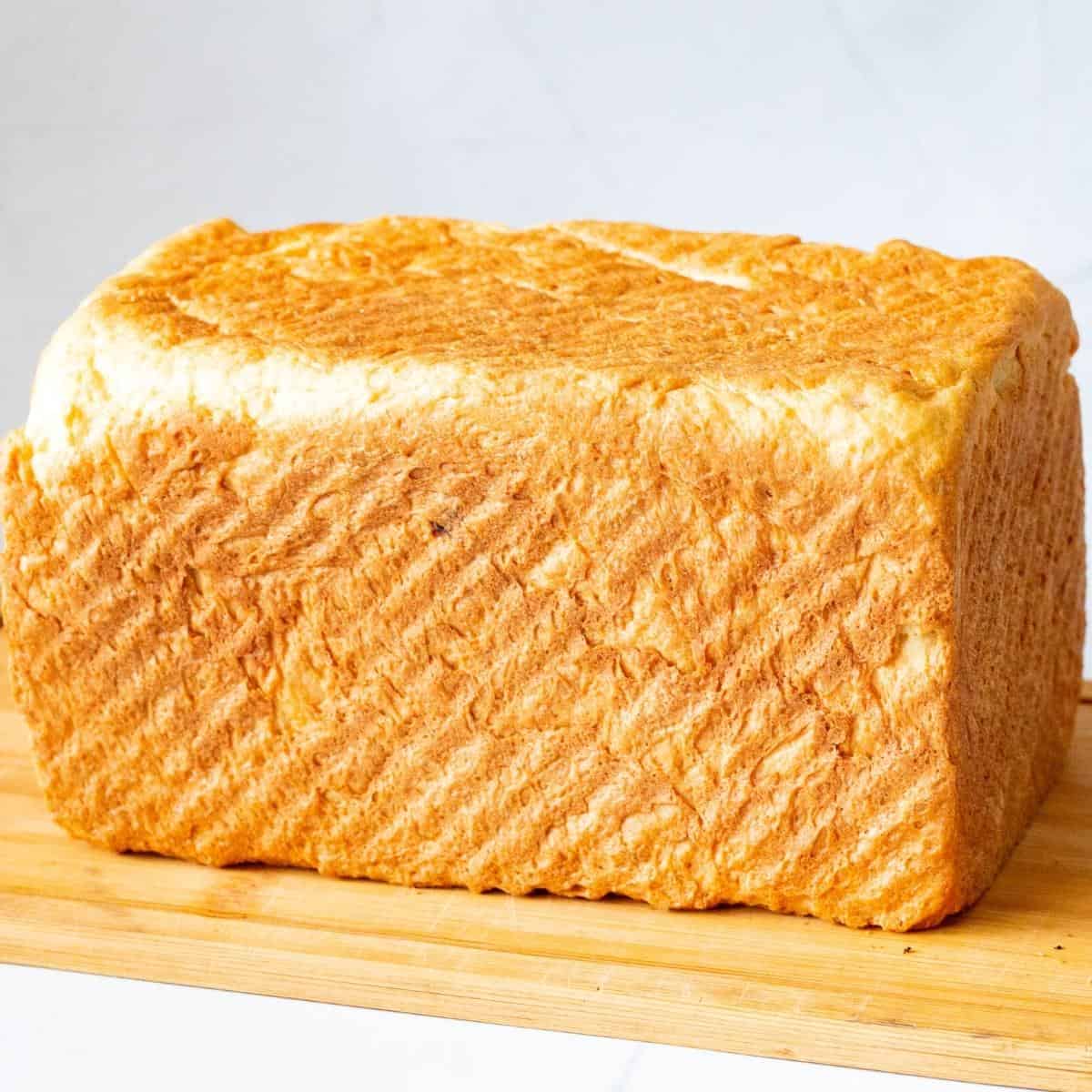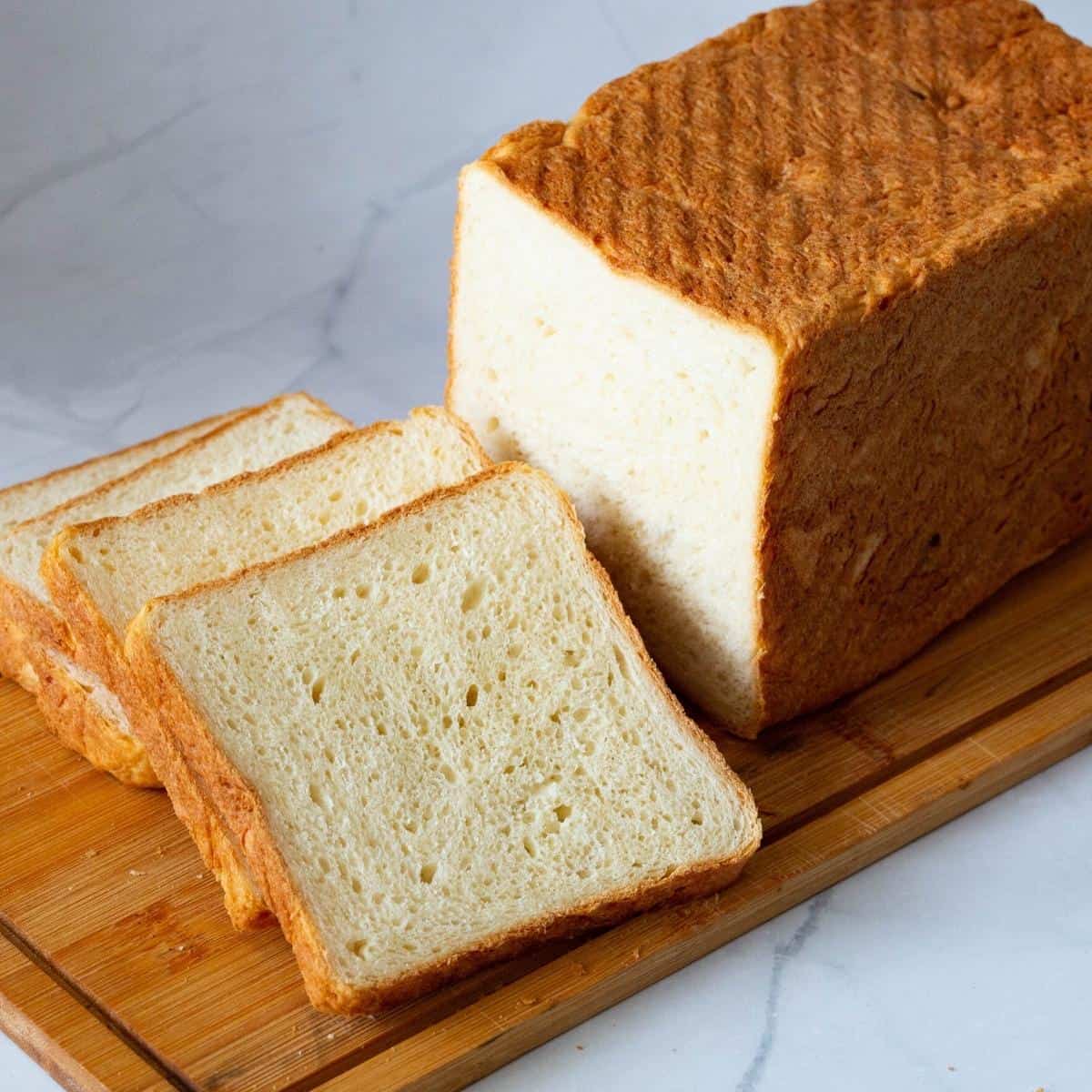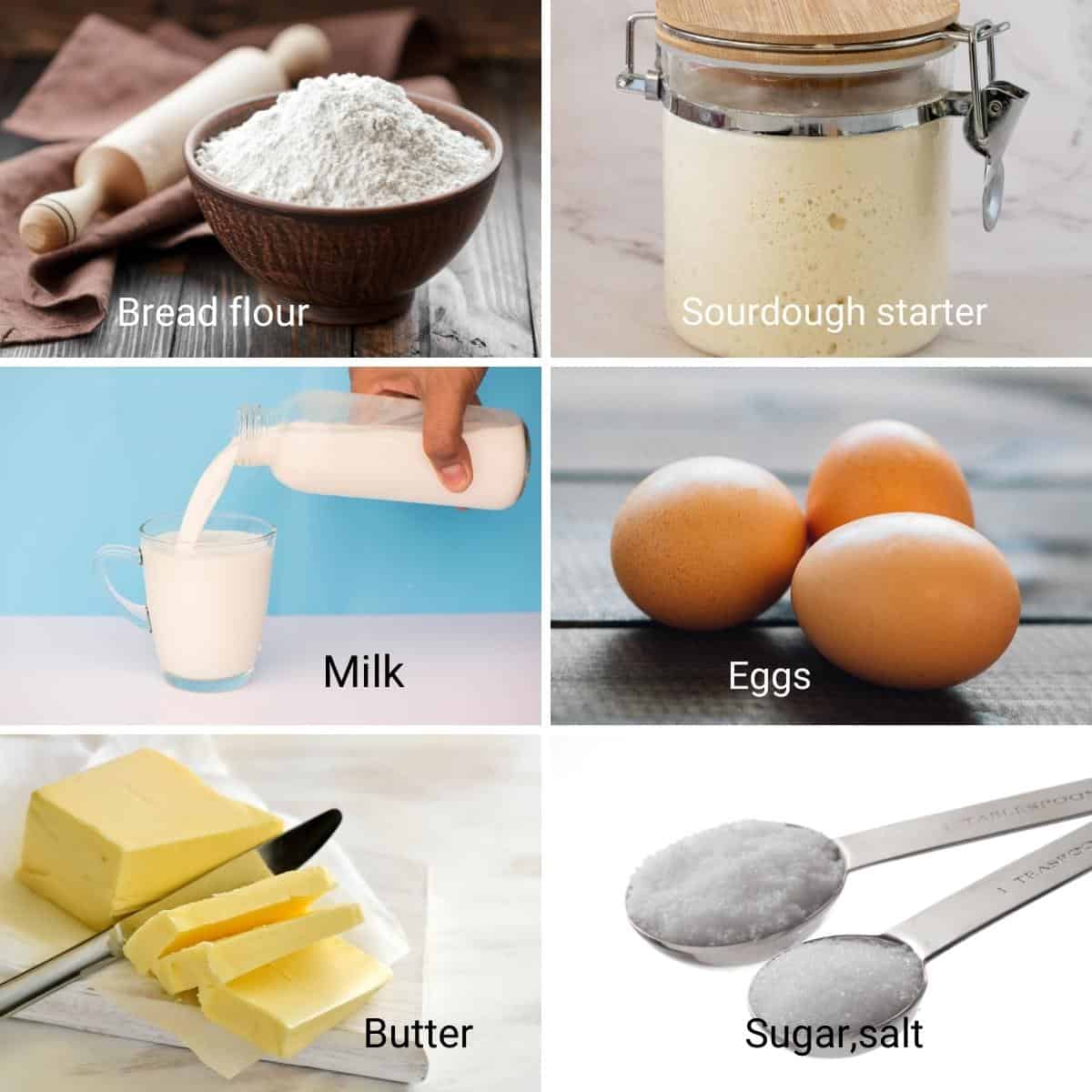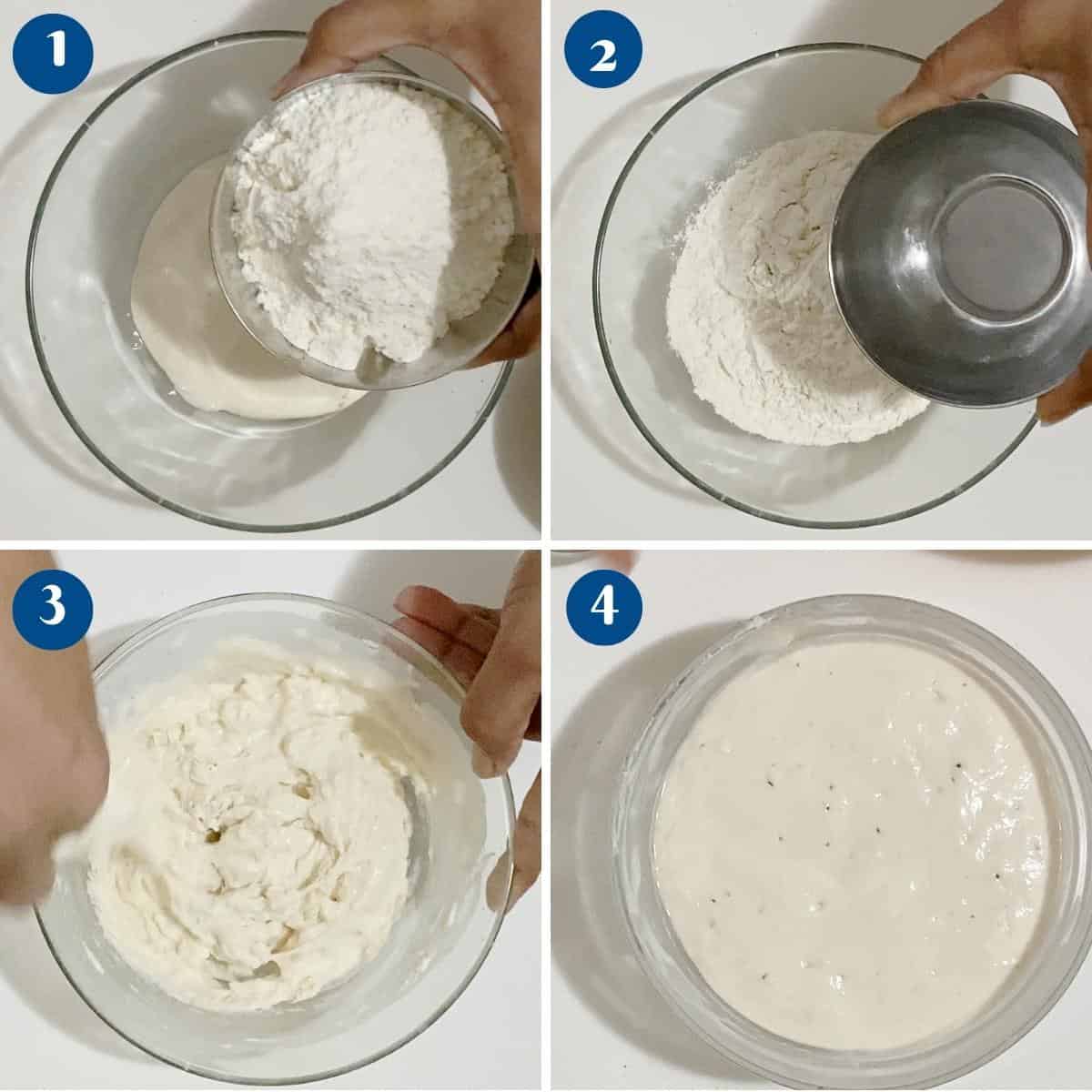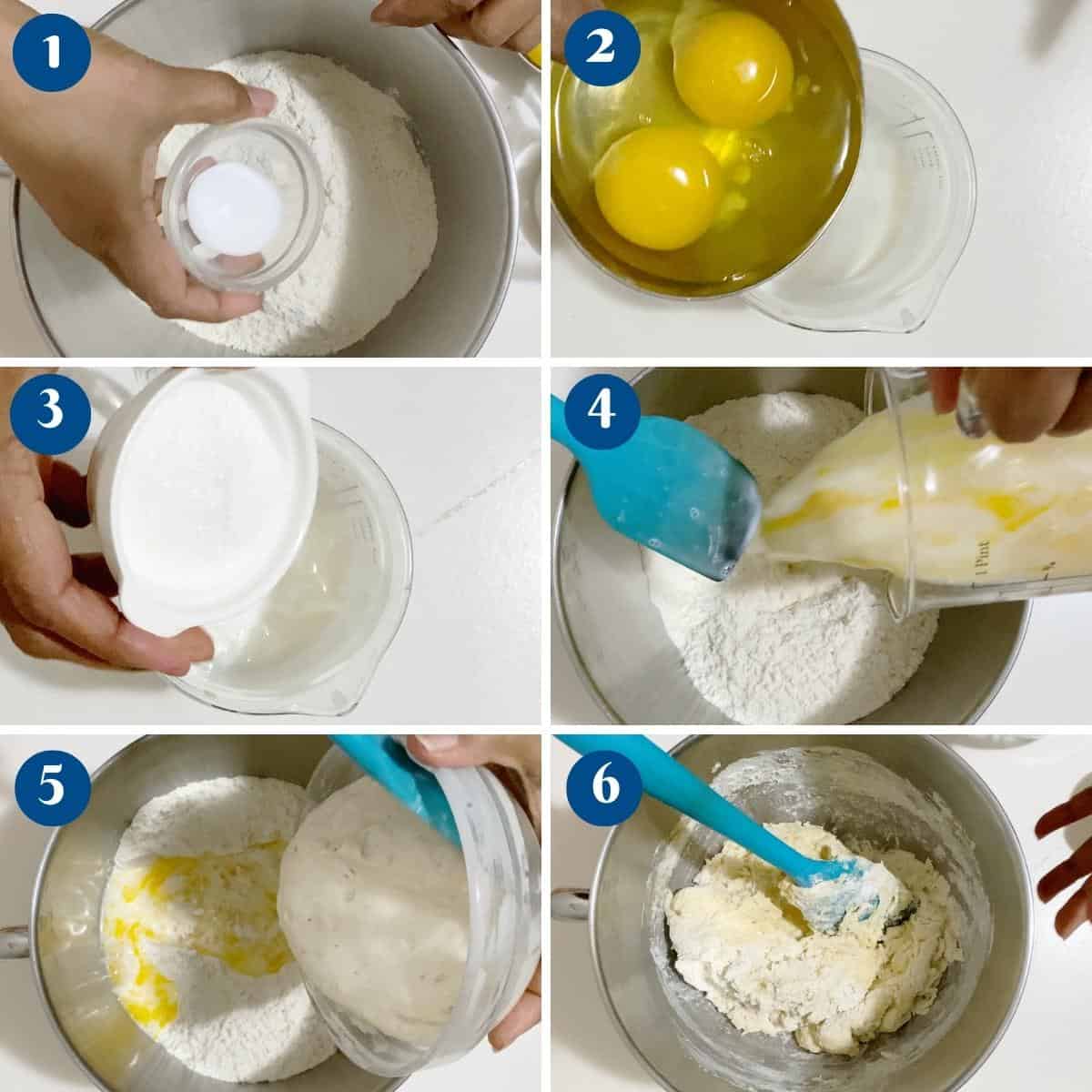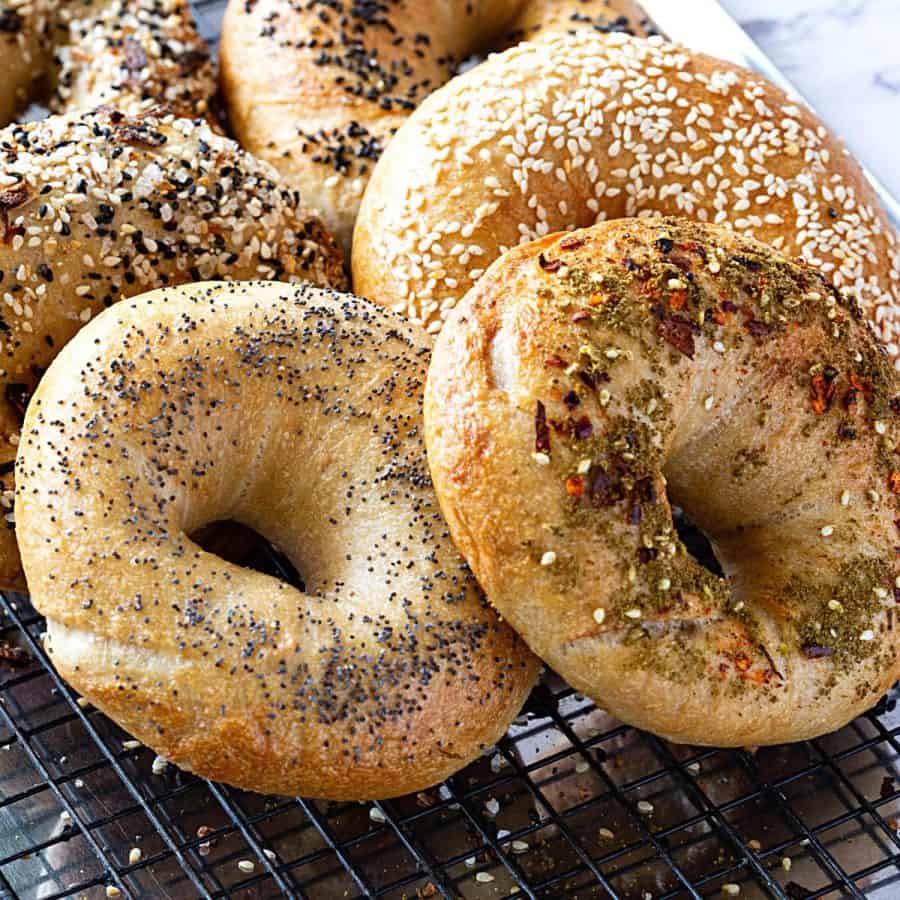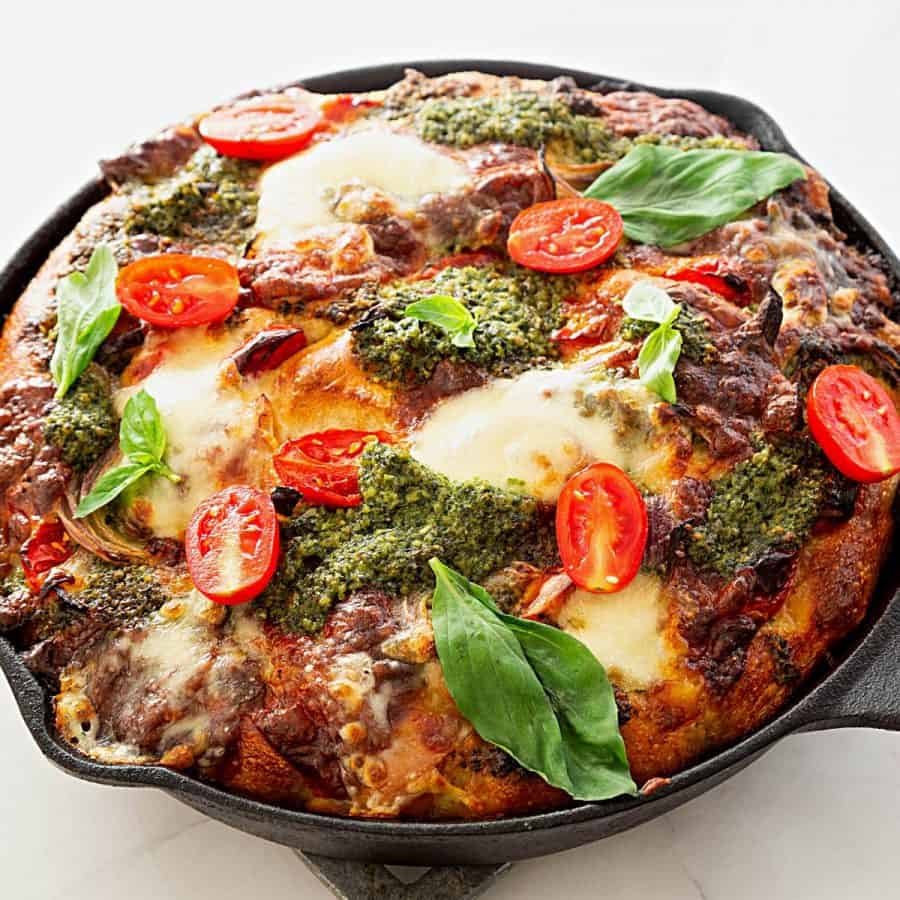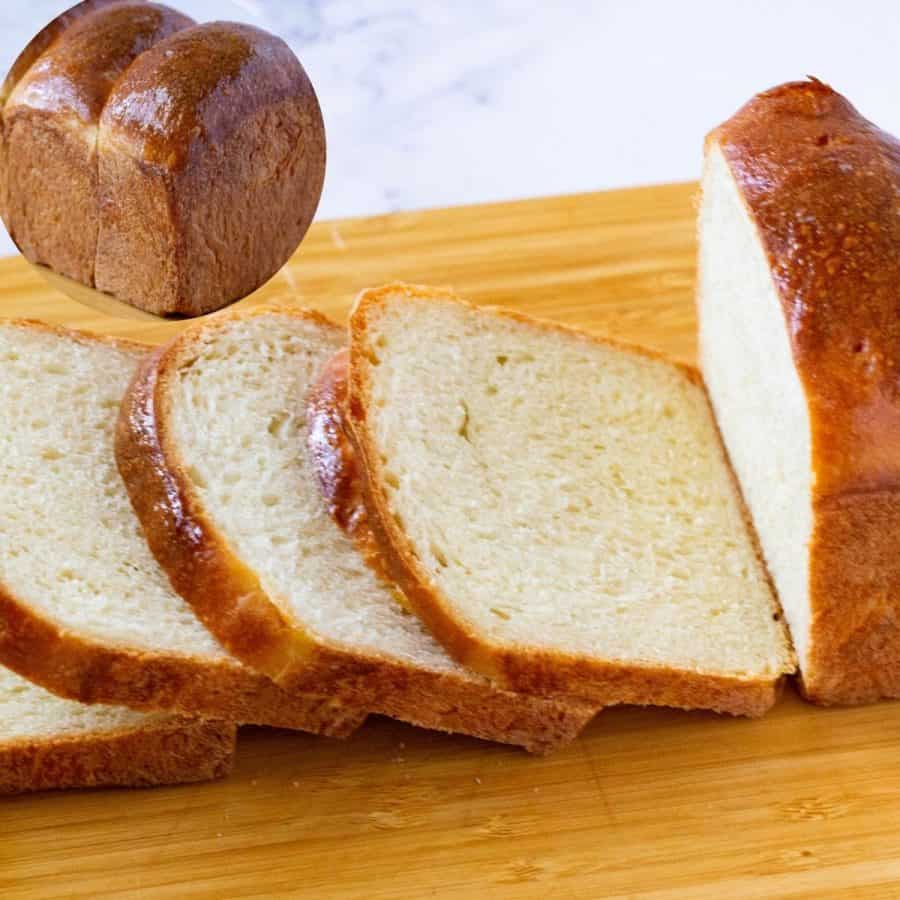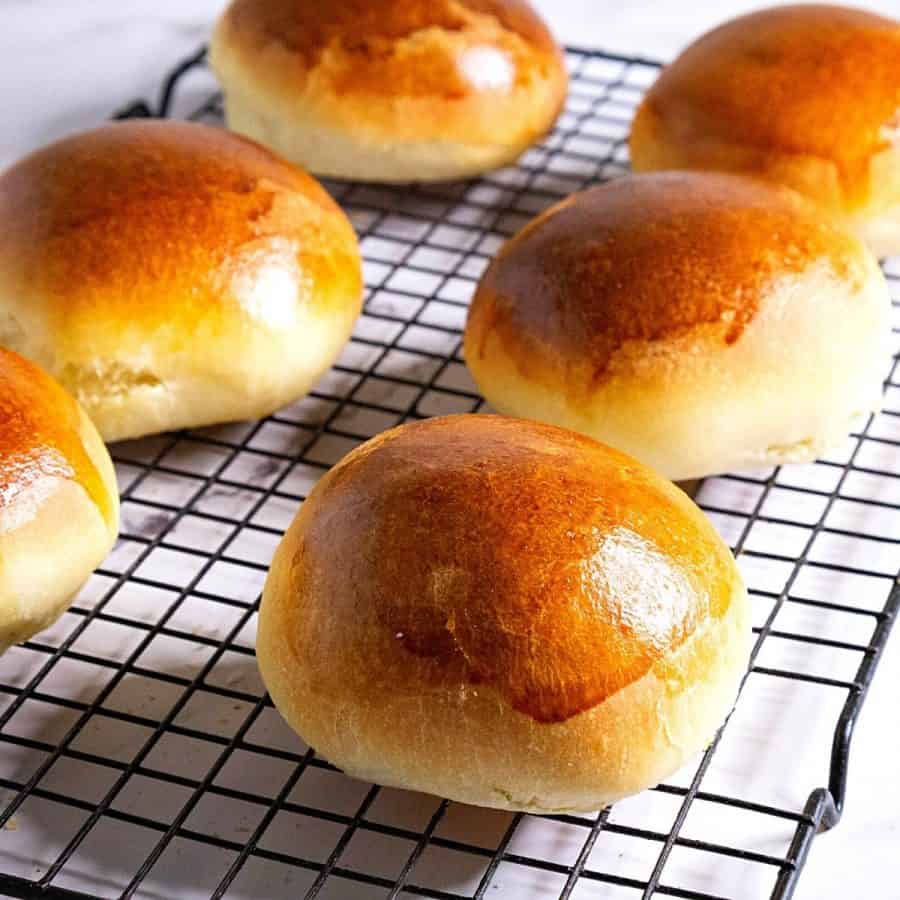Pullman bread, sometimes called ‘pain de mie,’ is baked in a square or rectangular pan with a lid. This lid ensures the bread is perfectly square, ideal for sandwiches. Sourdough combines the magic of wild yeast, the richness of high-quality flour, and a few other pantry staples. It can satisfy your taste buds and elevate your bread game to new heights. So, get ready to enjoy the deliciousness of homemade bread and become a true bread maestro. Following this step-by-step guide will equip you with the knowledge and skills to create delicious sourdough pullman bread from scratch. With practice, you’ll be able to achieve consistent results and enjoy the satisfaction of homemade bread. Please note that I have taken for granted that you already have access to an active sourdough starter.
Why is this sourdough the best for pullman bread?
First and foremost, this recipe calls for a lively sourdough starter. This natural leavening agent adds a complex tangy flavor and helps create a light and airy texture in the bread. By using a sourdough starter, you’re tapping into the power of fermentation, which not only enhances the flavor but also improves the digestibility of the bread. Additionally, this recipe emphasizes the importance of high-quality flour. The combination of bread flour and all-purpose flour adds depth and texture to the bread’s flavor. The precise ratio of these flours ensures the right balance between structure and tenderness. Thus, resulting in a loaf that is both sturdy enough for slicing and delicate enough to melt in your mouth. Another key element that sets this recipe apart is the use of a Pullman loaf pan. With its distinct shape and lid, the Pullman pan creates perfectly squared slices, making it an ideal choice for sandwich-making. The enclosed environment also promotes even baking and helps achieve that desirable golden crust. Furthermore, the step-by-step instructions in this guide are designed to help you achieve consistent results every time. From the initial feeding of your sourdough starter to the final shaping and proofing of the dough. Each stage is clearly outlined to ensure precision and mastery. Finally, this recipe encourages experimentation and personalization. Whether you want to incorporate different flavors by adding herbs or spices, or you prefer to incorporate alternative grains, this recipe provides a solid foundation for your creativity.
Ingredients and substitutes
First and foremost, let’s talk about the star of the show: the flour. This recipe suggests using a combination of high-quality bread flour and all-purpose flour. However, you can also experiment with different types of flour to achieve different flavors and textures. For instance, whole wheat flour can add a nutty depth to your bread, while spelt flour imparts a unique earthiness. So feel free to mix and match different flours for a truly personalized loaf. Next up, is the sourdough starter. While we’ve recommended using a lively and well-fed starter for optimum flavor and rise, you can use different variations or even incorporate other fermented starters like rye or buckwheat. These variations will bring their own unique tang and complexity to your bread. This allows you to create a sourdough Pullman loaf that truly reflects your taste. We also use a few other ingredients to enrich the dough. Eggs can help give the bread a more tender crumb and a glossy surface. Butter adds flavor and helps create a soft crumb, while milk makes the dough easier to shape and increases the overall shelf life. Allowing the ingredients to come to room temperature can also improve the texture of the bread. Ultimately, the goal is to create an inviting, flavorful loaf of sourdough. This recipe also encourages you to experiment with flavors by adding herbs or spices to the dough. And this is where your creativity can truly shine. Consider incorporating aromatic herbs like rosemary or thyme for a savory loaf or spices like cinnamon and nutmeg for a delightful twist in a sweet bread. The possibilities are endless, and by personalizing the flavors, you can create a bread that perfectly complements your desired meal. Finally, if you have any dietary restrictions or preferences, there are many substitutes available. For instance, if you follow a gluten-free diet, you can explore alternative grains like teff or sorghum flour. Additionally, if you prefer a vegan option, you can replace dairy-based ingredients with plant-based alternatives like almond milk or coconut oil. Don’t be afraid to experiment and adapt this recipe to suit your needs.
Step-by-step: Sourdough Pullman sandwich bread
Activate starter – Make sure your sourdough starter is active. It should be bubbly and have doubled in volume after its last feeding.
Autolyze – Add the milk, eggs, and sugar in a large mixing bowl of a stand mixer. Combine well. Add the flour and salt, followed by the starter. Stir well with a wooden spoon or spatula. Then, cover the bowl and leave to rest for 60 minutes.Pro tip – Autolyze will help strengthen the gluten formation on the dough. I combined the wet and dry ingredients in the video separately, but you can do it all together in the stand mixer.
Knead – Next, knead the dough with a dough hook attachment on medium speed for 4 to 6 minutes. Then, add the soft room-temperature butter and knead for another 4 to 6 minutes or until smooth and elastic.Pro tip – The dough will still be soft yet smooth, shiny, and elastic when you do the windowpane test. Bulk ferment – Transfer the dough to an oiled bowl and cover it with plastic wrap or a kitchen towel. Leave the dough to rise in the refrigerator (38°F / 3°C) for 6 to 8 hours.Pro tip – The dough can be kept in the fridge for up to 24 hours. The highly enriched dough will rise slowly. Punch – When double in size, punch down and transfer to a clean work surface. Break any large air bubbles and shape the dough into a ball again.Pro tip – If you are not ready to shape and bake the dough, you can put it back into the oiled bowl and let it rise again in the fridge for another 6 to 8 hours.
Divide – Roll the dough into a cylinder and divide the dough into 4 portions. Alternatively, you can roll the dough into one large log to make a classic sandwich bread shape.Pro tip – Weigh the 4 portions to ensure they are similar in size. These will rise about an inch over the rim of the pan. Shape – Roll each portion into a tight roll. To do this correctly, flatten the dough on an unfloured surface. Then, fold the top and two sides in. Then, roll towards you into a sausage shape. Place the pieces into a buttered 9-inch Pullman sandwich loaf pan seam side down. Prove – Cover with a clean kitchen cloth or plastic wrap and leave in a warm place proof for about 1½ to 2 hours or until almost double in size.Pro tip – Spray the plastic wrap with oil to prevent it from sticking to the rolls. In summer, the dough may rise in 90 minutes, while in winter, it can take up to 3 hours. Preheat oven – Preheat the oven to 375°F / 190°C / Gas mark 5 for at least 20 minutes.
Bake: Once your dough is ready and the oven is hot, slide the lid onto your Pullman pan and bake for 35 to 40 minutes.Pro tip – Alternatively, you can bake for 25 minutes with the lid on, then remove the cover and bake for another 10-15 minutes or until the top is golden brown. Cool – Remove the bread from the pan and let it cool on a wire rack for at least an hour. Patience will reward you with better texture and decent slices.
Tips for making sourdough Pullman bread
Give it time: Sourdough Pullman bread requires patience. Allow for long fermentation periods to develop the complex flavors and texture. Giving your dough ample time to rise will enhance the overall taste and structure of your loaf. Don’t rush the process; savor the journey. Use a precise scale: Baking is a science, and precision is key. Invest in a reliable kitchen scale to accurately measure your ingredients. This ensures consistency and helps you achieve the desired results every time you bake. Remember, baking is both an art and a science—measurements matter! Temperature matters: Maintain a controlled environment for your dough to rise by paying attention to the temperature. Cooler temperatures will slow down fermentation, while warmer temperatures will speed it up. Experiment with different temperatures to see which yields the best flavor and texture for your desired pullman loaf. Shape it right: The shape of your pullman loaf can greatly impact its overall appeal and texture. To achieve a uniformly shaped loaf, use a Pullman pan with a lid. This will create a square-shaped loaf with a defined crust, perfect for sandwiches or toasting. Score with finesse: Scoring your bread dough allows it to expand properly during baking, creating a beautiful crust and preventing unwanted cracks. Use a sharp razor or bread tool to make confident, shallow cuts on the surface of your dough. Experiment with different scoring patterns to add a personal touch to your Pullman loaf. Remember, mastering sourdough Pullman bread is a journey. Practice, experiment, and refine your technique. With each bake, you’ll gain confidence and enjoy the satisfaction of transforming simple ingredients into a culinary masterpiece.
Troubleshooting tips
Dough Too Sticky – High hydration means a wetter dough. If it’s too sticky to handle, wet your hands a bit when shaping. Not Rising – There could be several reasons: your starter might not be active, the room might be too cold, or the dough might have been overworked. Feed your starter regularly and ensure it’s bubbly and active before using. Dense Bread – Over-proofing could be a culprit. Keep an eye on your dough during the final rise and bake it when it’s ready, not necessarily when the clock says so. Why is my crust so hard – Sourdough naturally has a chewier crust, but if it’s too hard, it might’ve been baked too long or at too high a temperature. Make sure to monitor your bread and adjust baking times if necessary.
Sourdough Focaccia Whole Wheat Sourdough Bread Sourdough Bagel Sourdough Focaccia with Pesto and Mozzarella Sourdough Donuts
Frequently asked questions
Creative ways to use pullman bread
Sandwiches with flair: Pullman bread’s rectangular shape and even slices make it an ideal choice for sandwiches. Whether you prefer classic combinations like turkey and Swiss or more adventurous fillings like avocado and bacon. The even slices and sturdy structure of Pullman bread will hold up to whatever tasty ingredients you choose. Plus, the slight tanginess of sourdough adds an extra layer of flavor to your sandwich creations. French toast with a twist: Take your weekend brunch to the next level by using pullman bread for French toast. Its sturdy structure and absorbent crumb will soak up the custard mixture beautifully, resulting in a perfectly crispy and custardy French toast. Serve it with a drizzle of maple syrup, a sprinkle of powdered sugar, or a dollop of your favorite fruit compote for a decadent and delicious treat. Croutons and breadcrumbs: Don’t let any part of your Pullman bread go to waste! Transform any leftover slices into homemade croutons by cutting them into cubes, tossing them with olive oil, salt, and your preferred seasonings, and baking them until golden and crispy. These crunchy croutons will add a delightful texture to salads or soups. You can also turn stale slices into breadcrumbs by pulsing them in a food processor until finely ground. Use them to coat chicken or fish, add texture to meatballs, or sprinkle over casseroles for a golden and crispy topping.
Did you LIKE this recipe? Save it for later. You can find my recipes on Pinterest. Follow me on Facebook, Twitter, and Instagram.Subscribe, and I’ll send you new recipes right to your inbox. Thank you for sharing - Save for later
